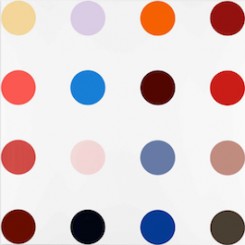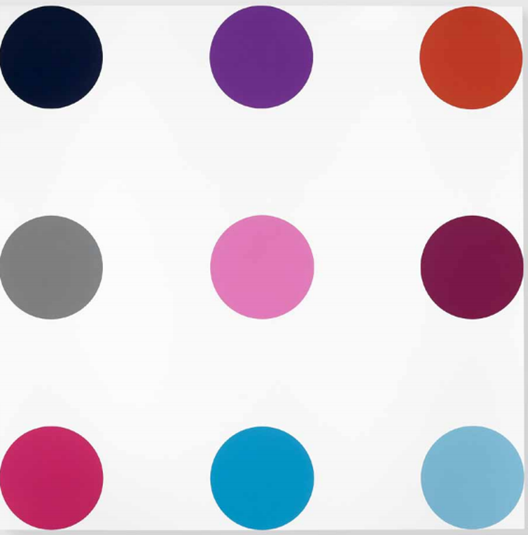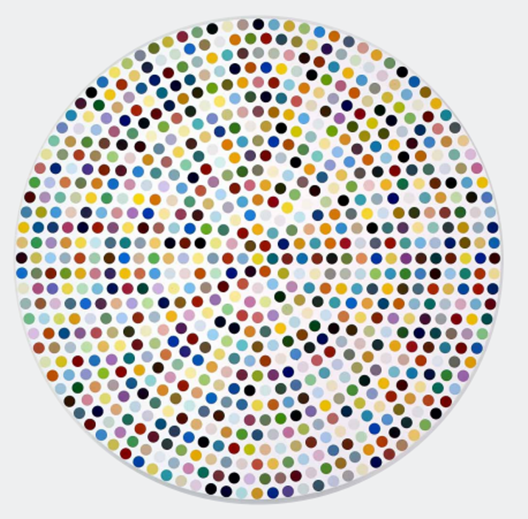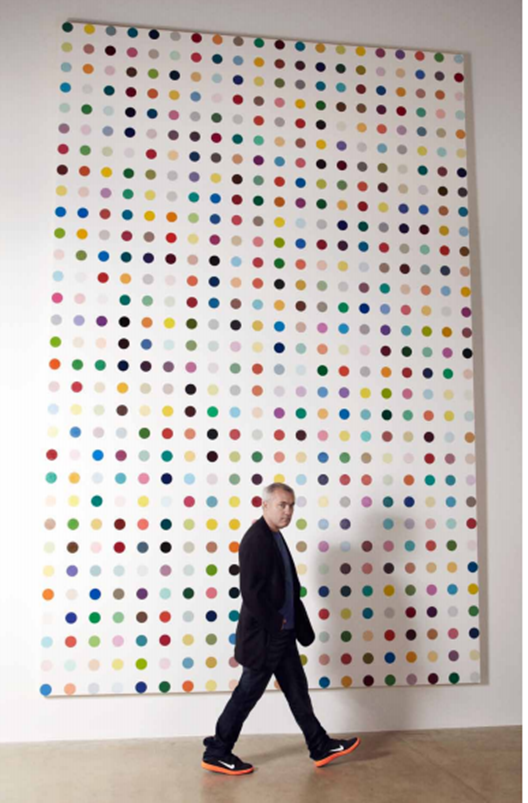by Chris Moore
“The Complete Spot Paintings 1986-2011,” solo exhibition by Damien Hirst.
Gagosian Gallery: 7/F Pedder Building, 12 Pedder Street, Central, Hong Kong. January 12 to February 18, 2012.
Picasso, Duchamp, Pollock, Warhol and Hirst at one time or other have been reviled in both the popular and academic press. Pause. This list summarizes the greatest achievements in art of the last 100 years. One could add others to the list too — Matisse, Barnett Newman, Beuys, Richter — but on the occasion of his intercontinental Spot Paintings show at all 11 Gagosian galleries, Hirst demands closer examination. Oh, yes he does — read on!
How many paintings are there altogether?
It does not matter. There are some 300 works in the exhibition, over 1,400 in existence, and a million-dot painting is in production. (1) But how many paintings or dots there are is irrelevant. Hirst developed rules for painting the dots. Philosophically, one could follow those rules and keep producing the spot paintings indefinitely and independently of Hirst until they covered the earth and outnumbered the stars. John Lennon meets Borges. So think of them as one single work, repeatable, expandable, and infinite.
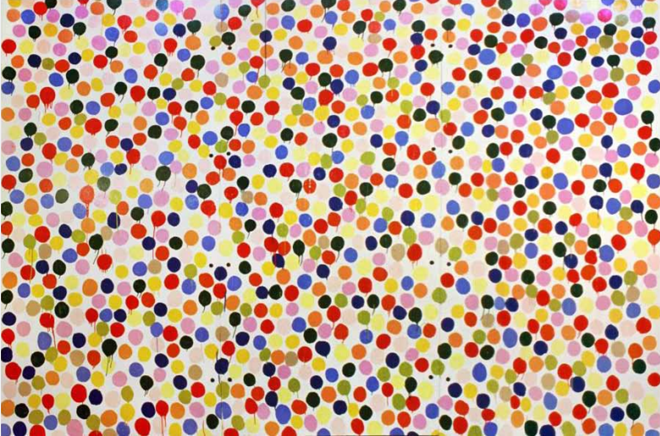
Damien Hirst, “Spot Painting,” The first spot painting, Household gloss on board, 243.8×365.8cm.(spot size variable),1986.
Like a disease!
Yes, like a disease. Hirst’s art is about mortality and communication. The dots are just a vehicle for communicating the idea, like a virus or the hatchling that attaches to John Hurt’s face in Ridley Scott’s film Alien. The art is in your head. Life is a terminal disease spread by communication, whether sexual, social, political, or pharmaceutical.
Rubbish. This is just pretentious hogwash, like the pharmaceutical-inspired titles to the paintings.
Did I emphasize that it is already in your head? You are infected now. Nothing you can do. But the titles are important — Hirst is a conceptual artist, so they are particularly important. These drugs represent every aspect of life — birth, reproduction, entertainment, prolongation — and also the sum of our fears. This is the dark side to the relentless happiness the paintings reflect.
But isn’t it just wallpaper?
It is also wallpaper but also many other things. So are Michelangelo’s frescoes. Calling something “just wallpaper” is not serious examination but a device to avoid it. Just substitute any of the following adjectives: monstrous, evil, gorgeous, super.

A ridiculous comparison!
Bathetic, not ridiculous.
“I believe that after Jackson Pollock created a distance between the brush and the canvas by flinging the paint, there was nowhere to go with painting… The urge to be a painter is still there even if the process of painting is meaningless, old-fashioned. Today there are better ways to communicate to an audience raised on television, advertising and information on a global level.” (2)
He’s right. Why is it that we still want to paint? And note, he doesn’t say that “painting” is meaningless but that the “process” is. This is about the media of paint, a tool for communication.
But Hirst doesn’t even paint them himself!
Why should he? He’s developed perfectly clear rules as to how the paintings should be produced
• In any one painting, all the spots must be the same size.
• The distance between the spots must be the same as the spots themselves — harmony (a grid).
• Each spot must be a different color – disharmony (the human paradox — everyone is identically different).
• The colors must be distributed randomly.
[...Of course the rules are often broke(n) — the separations bigger than required, and as for random distribution of color, difficult to achieve without a prescribed system, which, of course, ushers in choice once more... viz. Eno's cards (swapping the instruments for Bowie's "Boys Keep Swinging").]
Hang on, who’s he?
That’s Ge Si Di. Don’t worry, he’s always butting in. Anyway, as the exhibitions demonstrate, the size and shape of the paintings may vary infinitely.
A glib little game!
Not at all. We are surrounded and governed by “meaningless” rules. Every painting is identical and every painting is different. Does the metaphor ring a bell? It sounds trite until one adds interchangeable and reproducible, and then it’s sinister. Your aesthetic taste has been manufactured. It is not a gift from god but a product of genetics and socialization. It is not original.
He doesn’t even paint them himself.
The first few Hirst did himself but he thinks the latter versions are better. In fact, he has said that Rachel Howard painted the best Spot Paintings. (3)
“I only ever made [sic] five spot paintings myself… and my spots I painted are shite.”
[GSD — The early paintings by Hirst himself are better.]
(Who asked you anyway?) The dots are unoriginal. Lots of artists have done dots since Seurat.
Your observations are so original. There are huge numbers of different dot paintings by different artists. Personally I like John Armleder’s very much. They are not the same as Hirst’s, which in some senses actually have nothing to do with painting (but I’m getting ahead of myself — more on that shortly). Yayoi Kusama also explores the relationship between sculpture, color, form and spotted surfaces. In fact, Hirst is a fan of Kusama. See for instance Hirst’s interview of Kusama in the catalog to her “Now” exhibition in 1998 at Robert Miller Gallery, New York. (4) But you haven’t been paying attention. The dots are not meant to be original but are about the impossibility of “originality” that art, and more generally human culture itself, has achieved — not “reached” but “achieved.” Culture, far from lineal — always a suspect notion — turns out to be molecular and frequently random.
I could paint them myself!
You could, particularly if you bought “Painting-By-Numbers” (2001), a DIY spot painting kit.

I think I’m going to vomit.
Catharsis is good, but maybe wait for Hirst’s Tate Modern retrospective this year. “A Thousand Years” (a vitrine with maggots and flies feeding off a cow’s head, 1991) will help you. (5) But your comment brings me back to Pollock, who famously worked “in” the painting, producing what became known as the “all-over” effect. Being “in the painting” emphasized the sculptural architecture of painting. On the one side the spot paintings are a mise-en-abyme, a paradox of infinite superficiality and possibility. On the other, they are background to the mise-en-scene. The art happens right where you’re standing.
“They have nothing to do with Richter or Larry Poons or Bridget Riley or Josef Albers or even Op Art. They’re about the urge or the need to be a painter above and beyond the object of a painting. I’ve often said that they are like sculptures of paintings.” (6)
That last sentence initially appears to be a non sequitur…
Oh for @#$%’s sake!
…but only if you think of the Spot Paintings as flat images on a computer screen or in a magazine. They hang in space (like all paintings) and have been made consciously, by an artist who is principally a conceptual sculptor/installation artist. As many images of the exhibitions attest, frequently the experience of these paintings, some of which are huge, involves other people in the foreground. This happens with paintings all the time but normally it goes unnoticed unless you’re craning your head for an oblique glimpse of the Mona Lisa. Hirst makes it a central theme, the friction between painting and viewer as object.
Ooh, move over Descartes! Step up, Mr Hirst! Take your place in the Pantheon!
His is not a critical synthesis of certain tenets of Cubism, Formalism, Dada, Abstract Expressionism, Color Field, Op Art, Pop, Conceptual Art and Post-Modernism, but a seductively and calculatedly bland one. All art ends up as decoration. He makes you feel good about nihilism. This is critical, not cynical. The warming ambrosia is laced with strychnine (which, by the way, has sometimes been used as a stimulant). Pharmaceuticals can be poisonous.
And this is art criticism.
Yes, it is! (smile)
Shoot me now.
Funny you should say that. Hirst’s extensive private collection, which will open to the public soon at the converted Toddington Manor in England, is called the “murderme collection.” As well as works by Francis Bacon and Jeff Koons and many of his British contemporaries, Hirst also collects a lot of work by young artists. It’s in the country, a bit like in the video he directed for Blur’s “Country House.”
But I digress, the critical element concerns Warhol’s and Benjamin’s pet itch —
…Benjiwho?!…
Benjamin, Walter Benjamin. And the other guy is Warhol, Andy… anyway, as I was saying, reproduction, reproducibility — because sex and copying have stuff in common — agency, originality, production, consumption, really all the big themes in art of the past century, are tied up, emblematized, criticized, exploited and indulged in Hirst’s spots paintings.
Sounds fun.
Well, art is entertainment — Koons, Murakami, Duchamp and Picasso would all agree, but then so would Klimt too, and he just made art for chocolate boxes. Sometimes art is meant to make you happy.

See, it’s a joke.
Didn’t you see that parenthetical smile (above)? It is a joke! That’s part of its attractive vertigo. The chutzpah of putting on a show of 300 paintings of spots in 11 galleries across three continents is also a joke, a very funny one. ![]()
Whatever you say, they are just superficial.
You’re on fire today. All painting is superficial. That is what painting is. Go back and read from the top.
[GSD — The whole business brings us back to painting — which I guess is the point rather than a negation of painting or a requiem for painting.]
You’re both just being provocative. The spot paintings are boring.
Quite. Provocatively boring. Boring things surrounds us — it’s part of life, so why shouldn’t it be an important part of our art?
I’m not having any of it! This is just excessive and egotistical!
Clearly you don’t know many artists. As Oscar Wilde said, “Moderation is a fatal thing… Nothing succeeds like excess.” The Complete Spot Paintings is intended to be excessive. It is, among other things, about excess. And this excess reflects the excess in ordinary life that we take for granted, including regarding sex, food, laws, cars, legal and illegal drugs, violence, oil, waste, diamonds, forest-clearing, air-travel….
How arrogant!
Hirst does not force people to buy his art or to visit his exhibitions or to read about him, or to do anything they don’t want to. What’s your problem?
Well, I prefer real paintings like Lucien Freud’s.
Well that is a problem but I can’t help you, though a shot of adrenalin might. Or LSD. Frankly anything to make them interesting and stop your blood pressure dropping dangerously low. I’m sure something can be found for you in one of Hirst’s titles. What do you mean by “real paintings” anyway? Everything Freud had to say, was said decades earlier by another English introvert, Stanley Spencer. (I hope you’re paying attention here too, Jenny Saville.)
Next you’ll be saying that Hirst’s paintings at the Wallace Collection are good.
The artwork is good: appropriation of a traditional museum and artists. Unique.
Just a moment, Randian is about art and China — what’s the connection?
You mean apart from the exhibition including Hong Kong? Well, an interesting connection is the British abstract painter John Hoyland, who died in July 2011. Hirst admired Hoyland and even interviewed him for the Royal Academy in London. Among Hoyland’s umpteen influences was a voracious interest in Chinese painting. (7) Otherwise I’m struggling. Oh, and Rachel Howard’s recent works look a bit Literati-ish.
What a joke! I am really NOT convinced!
You don’t want to be. But whatever — I don’t care what you don’t think. Everything will be the same, a thousand years hence. (8)
[GSD — One could of course subtend the whole thing and just paint. It's a culturally specific complaint — post-modernist disappointment. A malady from which others do not suffer.]
@#$%off!
Hirst says that too. Frequently.
 ENDNOTES:
ENDNOTES:
1. Leon Watson, “Spot the difference: Damien Hirst painted only FIVE of the 300 spot paintings in his latest collection,” The Daily Mail, January 13, 2012.
2. Damien Hirst, “On Dumb Painting,” originally published in I Want to Spend the Rest of My Life Everywhere, with Everyone, One to One, Always, Forever, Now. (London: Booth-Clibborn Editions, 1997).
3. Gordon Burn and Damien Hirst, On the way to work (London: Faber and Faber, 2001).
4. Damien Hirst, “Damien Hirst Questions Yayoi Kusama across the water, May 1998” in “Yayoi Kusama. Now,” June 11–August 7, 1998, Ex. Cat., (Robert Miller Gallery: New York, 1998). This exhibition coincided with a retrospective exhibition at the Museum of Modern Art, the culmination of the resurrection of her career that had begun with in 1989 with a retrospective at New York’s Center for International Contemporary Arts.
5. Incidentally, it was the first work Hirst sold to Charles Saatchi.
6. Hirst, “On Dumb Painting”, op cit.
7. “Hoyland and Hirst,” RA Magazine (Autumn 2009). Republished on Royal Academy website, “Royal Academy Blog: Hoyland and Hirst” (August 2, 2011).
8. A reference to Satan being thrown into the bottomless pit at the end of time for a thousand years (indeed, contradictions in terms are a particular strength of the Bible) but not such a bad fate compared with that of Sisyphus. Obviously this is also the source of Hirst’s “A Thousand Years.”
Quote at beginning of article —
You do not like them.
So you say.
Try them! Try them!
And you may.
Try them and you may, I say!
Dr. Suess. “Sam-I-am,” in Dr. Seuss’s Green Eggs and Ham (New York: Beginner Books, 1960).



